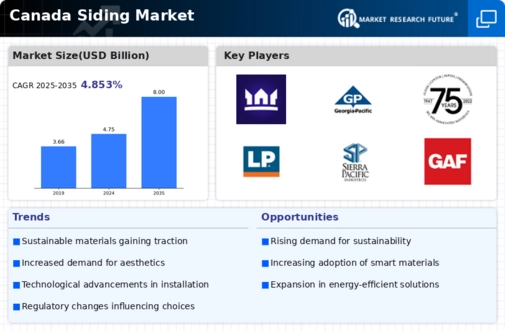Economic Growth and Investment
Economic growth in Canada plays a pivotal role in shaping the siding market. As the economy expands, disposable incomes rise, leading to increased consumer spending on home improvement and construction projects. Recent statistics indicate that the Canadian economy is projected to grow by approximately 2.1% in the coming year, which may stimulate demand for siding materials. Additionally, increased investment in infrastructure and residential development further propels the market. This economic environment encourages homeowners and builders to invest in high-quality siding options, thereby enhancing the overall market landscape. Consequently, economic growth serves as a fundamental driver for the siding market, influencing both demand and investment.
Rising Construction Activities
The siding market in Canada is experiencing a surge due to rising construction activities across both residential and commercial sectors. According to recent data, the construction industry has seen a growth rate of approximately 3.5% annually, which directly correlates with increased demand for siding materials. This growth is fueled by urbanization, population growth, and a robust housing market. As new homes and commercial buildings are erected, the need for durable and aesthetically pleasing siding options becomes paramount. This trend not only boosts sales for manufacturers but also encourages innovation in product development, as builders seek materials that offer both functionality and visual appeal. Thus, the expansion of construction activities serves as a significant driver for the siding market.
Regulatory Compliance and Standards
The siding market in Canada is increasingly influenced by regulatory compliance and standards that govern building materials. These regulations often emphasize energy efficiency, fire resistance, and environmental impact. As a result, manufacturers are compelled to innovate and adapt their products to meet these stringent requirements. For instance, the Canadian government has set ambitious targets for reducing greenhouse gas emissions, which may drive demand for siding materials that contribute to energy-efficient buildings. This regulatory landscape not only shapes product offerings but also impacts market dynamics, as companies that fail to comply may face penalties or lose market share. Consequently, adherence to these regulations is crucial for success in the siding market.
Technological Innovations in Manufacturing
Technological innovations in manufacturing processes are significantly impacting the siding market in Canada. Advances in production techniques, such as automation and improved material formulations, are enabling manufacturers to produce siding products that are not only more durable but also environmentally friendly. For instance, the introduction of advanced composite materials has led to the development of siding that offers superior performance while reducing waste. This trend is likely to attract environmentally conscious consumers and builders who prioritize sustainability. Furthermore, these innovations may lead to cost reductions in production, allowing companies to offer competitive pricing. As a result, technological advancements are a crucial driver influencing the evolution of the siding market.
Consumer Preferences for Low-Maintenance Solutions
In the Canadian siding market, there is a noticeable shift in consumer preferences towards low-maintenance siding solutions. Homeowners are increasingly seeking materials that require minimal upkeep, such as vinyl and fiber cement, which offer durability and resistance to weathering. This trend is likely influenced by the busy lifestyles of consumers who prefer products that do not necessitate frequent repairs or repainting. Market data suggests that low-maintenance siding options have gained a market share of over 40% in recent years. As consumers prioritize convenience and longevity, manufacturers are responding by expanding their offerings of low-maintenance products. This evolving consumer preference is a key driver shaping the future of the siding market.



















Leave a Comment